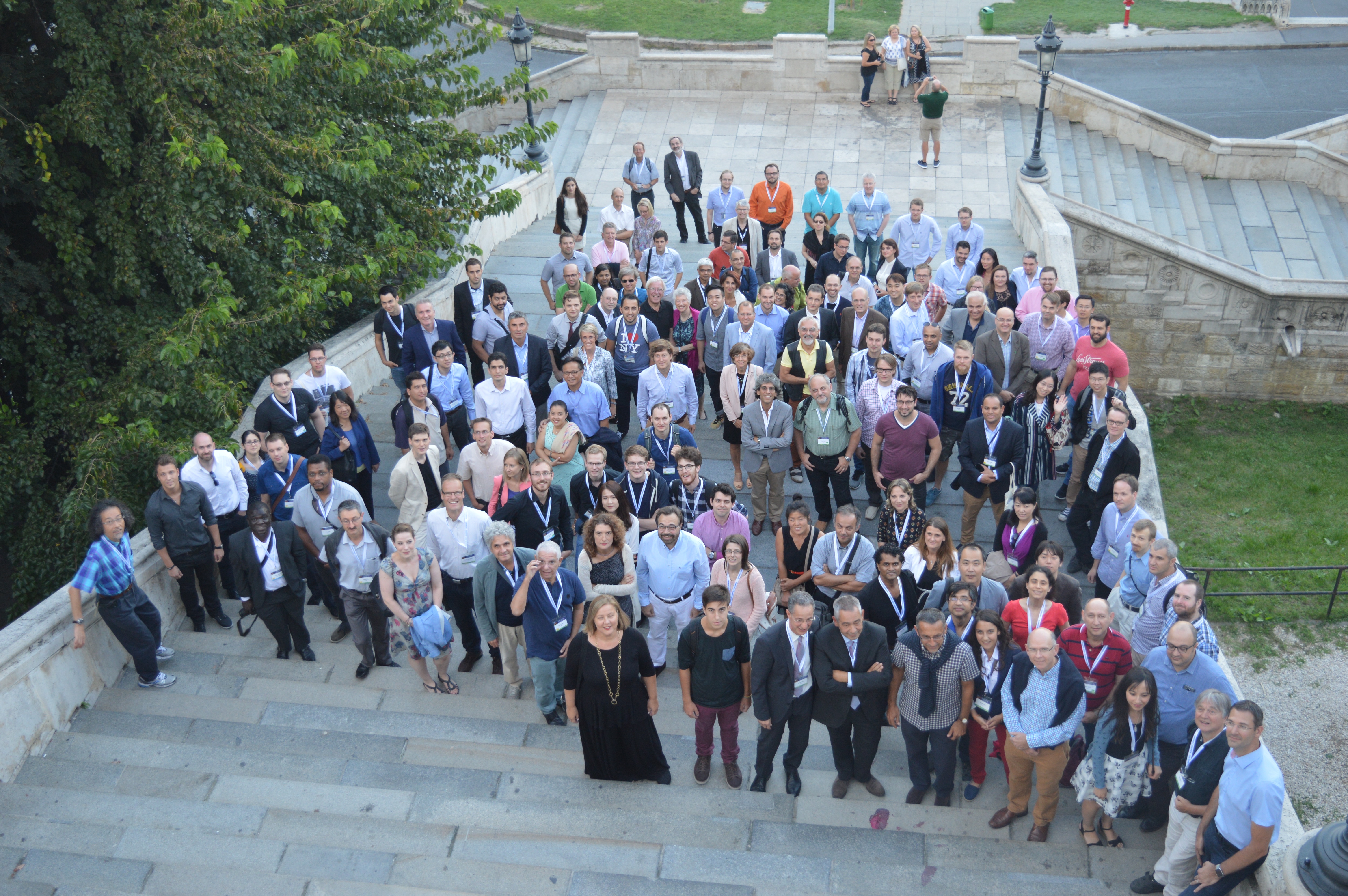Keynotes
| Technical Program
| Special Sessions
| Tutorials | Co-Located Events | EURASIP |
Last minute changes
| 3MT
| MathWorks workshop
| | | |
Morning Tutorials
Sparse Sensing for Statistical Inference
Geert Leus (Delft University of Technology, Netherlands), Sundeep Prabhakar Chepuri (Delft University of Technology, Netherlands) - Presentation
Graph Signal Processing: Fundamentals and Applications to Diffusion Processes
Alejandro Ribeiro (University of Pennsylvania), Antonio G. Marques (King Juan Carlos University), Santiago Segarra (University of Pennsylvania) - Presentation
Robust Covariance Matrix Estimators for Sparse Data Using Regularization and RMT
Esa Ollila (Aalto University), Frédéric Pascal (CentraleSupelec) - Presentation1, - Presentation2
Analysis of Texture and Oriented Patterns in Biomedical Images
Raj Rangayyan (University of Calgary, Calgary, Alberta) - Presentation1, Presentation2, Presentation3
Raja Giryes (Tel Aviv University) - Presentation
Afternoon Tutorials
Tülay Adalı (University of Maryland), Dana Lahat (GIPSA Lab, Grenoble, France), Christian Jutten (GIPSA Lab, Grenoble, France) - Presentation
Network Localization and Navigation: from Theory to Practice
Moe Z. Win (LIDS, Massachusetts Institute of Technology, USA), Andrea Conti (ENDIF, University of Ferrara, Italy) - Presentation
Erik Reinhard (Technicolor R&I), Giuseppe Valenzise (CNRS / Télécom ParisTech), Frédéric Dufaux (CNRS / Télécom ParisTech) - Presentation
Rethinking Fourier Acoustics
Augusto Sarti (DEIB – Politecnico di Milano, Italy), Fabio Antonacci (DEIB – Politecnico di Milano, Italy), Lucio Bianchi (DEIB – Politecnico di Milano, Italy) - Presentation
Alessio Zappone (Technische Universitat Dresden, Germany), Marco Di Renzo (Paris-Saclay University), Eduard Jorswieck (Technische Universitat Dresden, Germany) - Presentation1, Presentation2
Sparse Sensing for Statistical Inference
Geert Leus (Delft University of Technology, Netherlands), Sundeep Prabhakar Chepuri (Delft University of Technology, Netherlands)
Abstract: Ubiquitous sensors generate prohibitively large datasets. Large volumes of such data are nowadays generated by a variety of applications such as medical imaging, localization and surveillance platforms, social networks, power networks, environmental monitoring, smart infrastructure, seismic processing, to list a few. The acquired data samples are stored locally and then transported to a central location (e.g., a server or cloud) to extract meaningful information.
Due to an unprecedented increase in the volume of the acquired data, it is becoming increasingly challenging to locally store and transport all the data samples to a central location for data/signal processing. This is because the amount of sampled data quickly exceeds the storage and communication capacity by several orders of magnitude. Since the data processing is generally carried out at a central location with ample computing power, mainly the sensing, storage and transportation costs form the main bottleneck. However, if we had some prior knowledge about the task we want to perform on the data, maybe just a portion of that data would be enough to reach the desired performance. The main goal of this tutorial is therefore to present topics that transform classical sensing methods, often based on Nyquist-rate sampling, to more structured low-cost sparse sensing mechanisms designed for specific inference tasks. More specifically, we present fundamental tools to achieve the lowest sensing cost with a guaranteed performance for the task at hand. The tutorial is very timely and touches upon problems in big data, internet-of-things, as well as compressive sensing. We further extend sparse sensing to important problems in data analytics such as sampling graph signals, sampling streaming data, and outlier rejection. Throughout this tutorial a significant attention will be given to illustrate the developed theory with a number of diverse examples related to localization, field estimation, spectrum sensing, and so on.
Brief biography of presenters
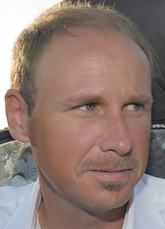 Geert Leus received the MSc and PhD degree in Applied Sciences from the Katholieke Universiteit Leuven, Belgium, in June 1996 and May 2000, respectively. Currently, Geert Leus is an "Antoni van Leeuwenhoek" Full Professor at the Faculty of Electrical Engineering, Mathematics and Computer Science of the Delft University of Technology, The Netherlands. His research interests are in the area of signal processing for communications. Geert Leus received a 2002 IEEE Signal Processing Society Young Author Best Paper Award and a 2005 IEEE Signal Processing Society Best Paper Award. He is a Fellow of the IEEE and a Fellow of EURASIP. Geert Leus was the Chair of the IEEE Signal Processing for Communications and Networking Technical Committee, and an Associate Editor for the IEEE Transactions on Signal Processing, the IEEE Transactions on Wireless Communications, the IEEE Signal Processing Letters, and the EURASIP Journal on Advances in Signal Processing. Currently, he is a Member-at-Large to the Board of Governors of the IEEE Signal Processing Society and a member of the IEEE Sensor Array and Multichannel Technical Committee. He finally serves as the Editor in Chief of the EURASIP Journal on Advances in Signal Processing.
Geert Leus received the MSc and PhD degree in Applied Sciences from the Katholieke Universiteit Leuven, Belgium, in June 1996 and May 2000, respectively. Currently, Geert Leus is an "Antoni van Leeuwenhoek" Full Professor at the Faculty of Electrical Engineering, Mathematics and Computer Science of the Delft University of Technology, The Netherlands. His research interests are in the area of signal processing for communications. Geert Leus received a 2002 IEEE Signal Processing Society Young Author Best Paper Award and a 2005 IEEE Signal Processing Society Best Paper Award. He is a Fellow of the IEEE and a Fellow of EURASIP. Geert Leus was the Chair of the IEEE Signal Processing for Communications and Networking Technical Committee, and an Associate Editor for the IEEE Transactions on Signal Processing, the IEEE Transactions on Wireless Communications, the IEEE Signal Processing Letters, and the EURASIP Journal on Advances in Signal Processing. Currently, he is a Member-at-Large to the Board of Governors of the IEEE Signal Processing Society and a member of the IEEE Sensor Array and Multichannel Technical Committee. He finally serves as the Editor in Chief of the EURASIP Journal on Advances in Signal Processing.
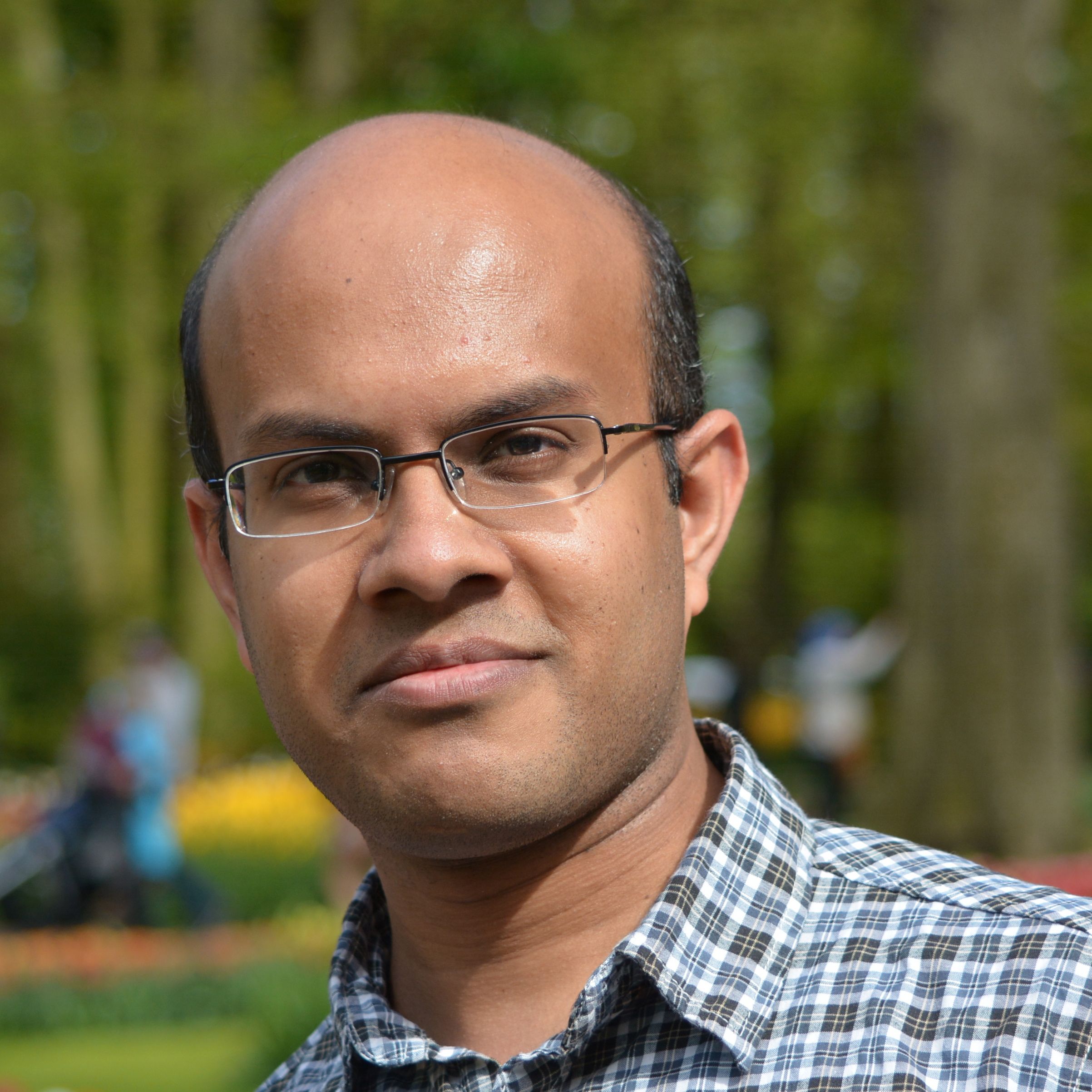 Sundeep Prabhakar Chepuri was born in India in 1986. He received his M.Sc. degree (cum laude) in electrical engineering and Ph.D. degree (cum laude) from the Delft University of Technology, The Netherlands, in July 2011 and January 2016, respectively. He has held positions at Robert Bosch, India, during 2007-2009, and Holst Centre/imec-nl, The Netherlands, during 2010-2011. He is currently a postdoctoral scholar with the Circuits and Systems group at the Faculty of Electrical Engineering, Mathematics and Computer Science of the Delft University of Technology, The Netherlands. His general research interest lies in the field of mathematical signal processing, statistical inference, sensor networks, and wireless communications. He was a recipient of the Best Student Paper Award at the IEEE International Conference on Acoustics, Speech and Signal Processing (ICASSP) in 2015.
Sundeep Prabhakar Chepuri was born in India in 1986. He received his M.Sc. degree (cum laude) in electrical engineering and Ph.D. degree (cum laude) from the Delft University of Technology, The Netherlands, in July 2011 and January 2016, respectively. He has held positions at Robert Bosch, India, during 2007-2009, and Holst Centre/imec-nl, The Netherlands, during 2010-2011. He is currently a postdoctoral scholar with the Circuits and Systems group at the Faculty of Electrical Engineering, Mathematics and Computer Science of the Delft University of Technology, The Netherlands. His general research interest lies in the field of mathematical signal processing, statistical inference, sensor networks, and wireless communications. He was a recipient of the Best Student Paper Award at the IEEE International Conference on Acoustics, Speech and Signal Processing (ICASSP) in 2015.
Graph Signal Processing: Fundamentals and Applications to Diffusion Processes
Alejandro Ribeiro (University of Pennsylvania), Antonio G. Marques (King Juan Carlos University), Santiago Segarra (University of Pennsylvania)
Abstract: Coping with the challenges found at the intersection of Network Science and Big Data necessitates broadening the scope beyond classical temporal signal analysis and processing in order to also accommodate signals defined on graphs. Under the assumption that the signal properties are related to the topology of the graph where they are supported, the goal of graph signal processing (GSP) is to develop algorithms that fruitfully leverage this relational structure. Instrumental to that end is the so-termed graph-shift operator, a matrix capturing the graphs local topology and whose spectral decomposition is central to defining graph Fourier transforms. In the last years a body of works has successfully implemented this approach, showing how several classical signal processing results can be gracefully generalized to the more irregular graph domain.
The tutorial consists of two parts of similar length: an introduction to the basics of GSP, which will review and illustrate main existing results, and the application of GSP-tools to distributed network processing and diffusion processes over networks. The first part introduces the field of GSP, motivates its usefulness via meaningful applications, and presents in a didactic yet concise manner its foundational concepts, which have been derived over the past five years. The second part focuses on contemporary results. We will first illustrate that GSP is well suited to model and study diffusion processes over networks. With this premise in mind, we revisit classical SP problems such as sampling, interpolation, system identification, and filtering. We first present the theoretical results and then discuss their implications for distributed and dynamic processing. Furthermore, we illustrate the utility of applying GSP to analyze dynamics on networks through a diverse gamut of applications from social sciences to biology, spanning well-established problems like consensus and emerging neuroscience challenges like brain state induction.
Brief biography of presenters
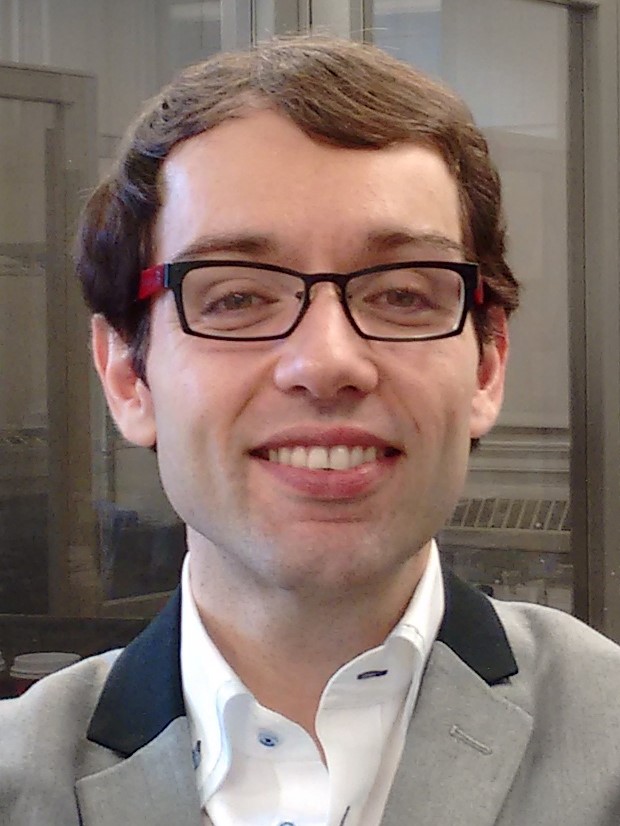 Antonio G. Marques received the Telecommunications Engineering degree and the Doctorate degree, both with highest honors, from the Carlos III University of Madrid, Spain, in 2002 and 2007, respectively. In 2007, he became a faculty of the Department of Signal Theory and Communications, King Juan Carlos University, Madrid, Spain, where he currently develops his research and teaching activities as an Associate Professor. From 2005 to 2015, he held different visiting positions at the University of Minnesota, Minneapolis. In 2015 and 2016 he was a Visiting Scholar at the University of Pennsylvania. His research interests lie in the areas of communication theory, signal processing, and networking. His current research focuses on stochastic resource allocation wireless networks and smart grids, nonlinear network optimization, and signal processing for graphs. Dr. Marques has served the IEEE and the EURASIP in a number of posts (currently, he is an Associate Editor of the IEEE Signal Process. Letters and of the EURASIP J. on Advances in Signal Process.), and his work has been awarded in several conferences and workshops.
Antonio G. Marques received the Telecommunications Engineering degree and the Doctorate degree, both with highest honors, from the Carlos III University of Madrid, Spain, in 2002 and 2007, respectively. In 2007, he became a faculty of the Department of Signal Theory and Communications, King Juan Carlos University, Madrid, Spain, where he currently develops his research and teaching activities as an Associate Professor. From 2005 to 2015, he held different visiting positions at the University of Minnesota, Minneapolis. In 2015 and 2016 he was a Visiting Scholar at the University of Pennsylvania. His research interests lie in the areas of communication theory, signal processing, and networking. His current research focuses on stochastic resource allocation wireless networks and smart grids, nonlinear network optimization, and signal processing for graphs. Dr. Marques has served the IEEE and the EURASIP in a number of posts (currently, he is an Associate Editor of the IEEE Signal Process. Letters and of the EURASIP J. on Advances in Signal Process.), and his work has been awarded in several conferences and workshops.
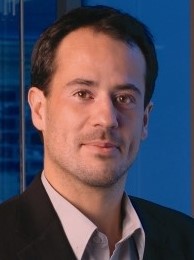 Alejandro Ribeiro received the B.Sc. degree in electrical engineering from the Universidad de la República, Uruguay, in 1998 and the M.Sc. and Ph.D. degree in electrical engineering from the Department of Electrical and Computer Engineering, the University of Minnesota, Minneapolis in 2005 and 2007. From 1998 to 2003, he was a member of the technical staff at Bellsouth Montevideo. After his M.Sc. and Ph.D studies, in 2008 he joined the University of Pennsylvania (Penn), Philadelphia, where he is currently the Rosenbluth Associate Professor at the Department of Electrical and Systems Engineering. His research interests are in the applications of statistical signal processing to the study of networks and networked phenomena. His current research focuses on wireless networks, network optimization, learning in networks, networked control, robot teams, and structured representations of networked data structures. Dr. Ribeiro received the 2014 O. Hugo Schuck best paper award, the 2012 S. Reid Warren, Jr. Award presented by Penn's undergraduate student body for outstanding teaching, the NSF CAREER Award in 2010, and student paper awards at the 2013 American Control Conference (as adviser), as well as the 2005 and 2006 International Conferences on Acoustics, Speech and Signal Processing. Dr. Ribeiro is a Fulbright scholar and a Penn Fellow.
Alejandro Ribeiro received the B.Sc. degree in electrical engineering from the Universidad de la República, Uruguay, in 1998 and the M.Sc. and Ph.D. degree in electrical engineering from the Department of Electrical and Computer Engineering, the University of Minnesota, Minneapolis in 2005 and 2007. From 1998 to 2003, he was a member of the technical staff at Bellsouth Montevideo. After his M.Sc. and Ph.D studies, in 2008 he joined the University of Pennsylvania (Penn), Philadelphia, where he is currently the Rosenbluth Associate Professor at the Department of Electrical and Systems Engineering. His research interests are in the applications of statistical signal processing to the study of networks and networked phenomena. His current research focuses on wireless networks, network optimization, learning in networks, networked control, robot teams, and structured representations of networked data structures. Dr. Ribeiro received the 2014 O. Hugo Schuck best paper award, the 2012 S. Reid Warren, Jr. Award presented by Penn's undergraduate student body for outstanding teaching, the NSF CAREER Award in 2010, and student paper awards at the 2013 American Control Conference (as adviser), as well as the 2005 and 2006 International Conferences on Acoustics, Speech and Signal Processing. Dr. Ribeiro is a Fulbright scholar and a Penn Fellow.
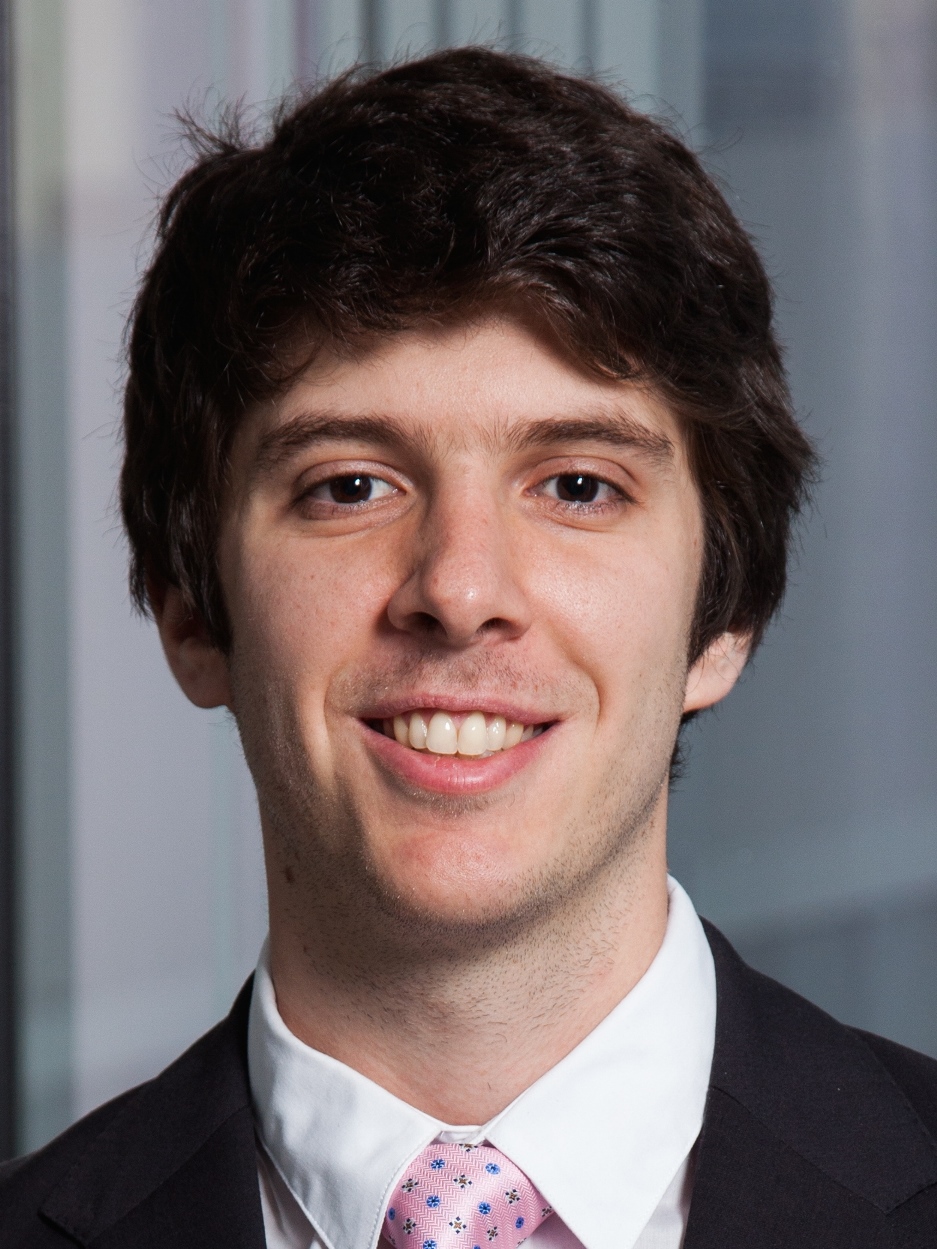 Santiago Segarra received the B.Sc. degree in industrial engineering with highest honors (Valedictorian) from the Instituto Tecnológico de Buenos Aires (ITBA), Argentina, in 2011 and the M.Sc. degree in electrical engineering from the University of Pennsylvania, Philadelphia, in 2014. Since 2011, he has been working towards the Ph.D. degree in the Department of Electrical and Systems Engineering at the University of Pennsylvania. His research interests span the areas of network theory, data analysis, machine learning, and graph signal processing, where he has published more than 40 conference and journal papers. Mr. Segarra, received ITBA's 2011 award to the best undergraduate thesis in industrial engineering, the 2011 outstanding graduate award granted by the National Academy of Engineering of Argentina, and the Best Student Paper Award at the 2015 Asilomar Conference.
Santiago Segarra received the B.Sc. degree in industrial engineering with highest honors (Valedictorian) from the Instituto Tecnológico de Buenos Aires (ITBA), Argentina, in 2011 and the M.Sc. degree in electrical engineering from the University of Pennsylvania, Philadelphia, in 2014. Since 2011, he has been working towards the Ph.D. degree in the Department of Electrical and Systems Engineering at the University of Pennsylvania. His research interests span the areas of network theory, data analysis, machine learning, and graph signal processing, where he has published more than 40 conference and journal papers. Mr. Segarra, received ITBA's 2011 award to the best undergraduate thesis in industrial engineering, the 2011 outstanding graduate award granted by the National Academy of Engineering of Argentina, and the Best Student Paper Award at the 2015 Asilomar Conference.
Robust Covariance Matrix Estimators for Sparse Data Using Regularization and RMT
Esa Ollila (Aalto University, Finlan), Frédéric Pascal (CentraleSupelec, France)
Abstract: We discuss recent advances in the robust covariance matrix estimation of multivariate high-dimensional (HD) sparse data, i.e., data for which the sample size n is smaller or not much larger than the dimension p of the data set, where p is potentially very large. Sparse data sets are becoming more commonplace in practice, particularly with the development of areas such as functional data analysis, multimedia imaging, social networking data, etc. Robust estimation is essential partly because outliers are more difficult to glean from high-dimensional data sets, but also due to an increase of impulsive measurement environments and outliers in practical sensing systems.
We consider a general class of regularized M-estimators of scatter (covariance) matrix which are defined as solution to a penalized M-estimation cost function that includes a fixed regularization parameter and a proper penalty function. Our developments are based on the concept of geodesic (g-)convexity of the target and the penalty function over positive definite matrices. Conditions for existence and uniqueness as well computation of the estimators are discussed and a large selection of g-convex penalty functions that can be used in our general framework are provided. Recent developments on robust structured covariance matrix estimation including Kronecker models are reviewed and the problem of simultaneous penalized M-estimation of covariance matrices of multiple classes is investigated.
Then, data are considered from a different perspective by using Random Matrix Theory (RMT). Indeed, the classical large sample asymptotic theory is not quite the correct tool when studying high-dimensional sparse data for which both n and p are large. In RMT, the dimension p is no longer fixed but tends to infinity in the same regime as the sample size n. This leads to many significant and profound differences in asymptotic analysis. More precisely, this approach allows obtaining closed-form expressions for regularized robust estimators, which is of particular interest for optimizing the regularized (penalty) parameters. Moreover, it will be shown that the RMT results provide similarities with the ones obtained in classical asymptotic regime. Applications include radar detection, regularized discriminant analysis and source localization.
Brief biography of presenters
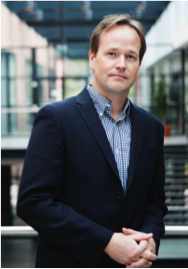 Esa Ollila received the M.Sc. degree in mathematics from the University of Oulu, in 1998, Ph.D. degree in statistics with honors from the University of Jyvaskyla, in 2002, and the D.Sc. (Tech) degree with honors in signal processing from Aalto University, in 2010. From 2004 to 2007 he was a post-doctoral fellow and from August 2010 to May 2015 an Academy Research Fellow of the Academy of Finland. He has also been a Senior Lecturer at the University of Oulu. Currently, he is an Associate Professor of Signal Processing at Aalto University. He is also an adjunct Professor (statistics) of Oulu University. Fall-term 2001 he was a Visiting Researcher with the Department of Statistics, Pennsylvania State University, while the academic year 2010-2011 he spent as a Visiting Post-doctoral Research Associate with the Department of Electrical Engineering, Princeton University. He is a member of EURASIP SAT in Theoretical and Methodological Trends in Signal Processing (TMTSP). His research interests contain multivariate analysis and robust statistics, statistical learning, radar and array signal processing and statistical signal processing at large.
Esa Ollila received the M.Sc. degree in mathematics from the University of Oulu, in 1998, Ph.D. degree in statistics with honors from the University of Jyvaskyla, in 2002, and the D.Sc. (Tech) degree with honors in signal processing from Aalto University, in 2010. From 2004 to 2007 he was a post-doctoral fellow and from August 2010 to May 2015 an Academy Research Fellow of the Academy of Finland. He has also been a Senior Lecturer at the University of Oulu. Currently, he is an Associate Professor of Signal Processing at Aalto University. He is also an adjunct Professor (statistics) of Oulu University. Fall-term 2001 he was a Visiting Researcher with the Department of Statistics, Pennsylvania State University, while the academic year 2010-2011 he spent as a Visiting Post-doctoral Research Associate with the Department of Electrical Engineering, Princeton University. He is a member of EURASIP SAT in Theoretical and Methodological Trends in Signal Processing (TMTSP). His research interests contain multivariate analysis and robust statistics, statistical learning, radar and array signal processing and statistical signal processing at large.
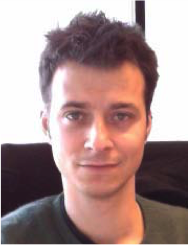 Frederic Pascal received the Master's degree ("Probabilities, Statistics and Applications: Signal, Image et Networks") with merit, in Applied Statistics from University Paris VII - Jussieu, Paris, France, in 2003. Then, he received the Ph.D. degree of Signal Processing, from University Paris X – Nanterre in 2006. From November 2006 to February 2008, he made a post-doctoral position in the Signal Processing and Information team of the laboratory SATIE, CNRS, ENS Cachan, France. Between March 2008 and December 2011 (resp. Jan. 2012 – Dec. 2013), he was an Assistant Professor (resp. Associate Professor) in SONDRA at CentraleSupelec. In 2012, he obtained a Research Directorship Habilitation (HDR) thesis in Signal Processing from the University of Paris-Sud. Between Aug. 2013 and Aug. 2014, he was a Visiting Associate Professor in the ECE department at the National University of Singapore. From January 2014, Frederic Pascal is a full Professor in the L2S laboratory at CentraleSupelec. From Sept. 2015, Frederic Pascal is the Chair of the EURASIP SAT in Theoretical and Methodological Trends in Signal Processing (TMTSP) and he is a member of the IEEE Signal Processing Society SAM technical committee (Jan. 2015-present). Frederic Pascal serves as an Associate Editor for the IEEE Transactions on Signal Processing (2015-present) and for the EURASIP Journal on Advances in Signal Processing (2015-present). His research interests contain estimation, detection and classification for statistical signal processing and applications in radar and image processing.
Frederic Pascal received the Master's degree ("Probabilities, Statistics and Applications: Signal, Image et Networks") with merit, in Applied Statistics from University Paris VII - Jussieu, Paris, France, in 2003. Then, he received the Ph.D. degree of Signal Processing, from University Paris X – Nanterre in 2006. From November 2006 to February 2008, he made a post-doctoral position in the Signal Processing and Information team of the laboratory SATIE, CNRS, ENS Cachan, France. Between March 2008 and December 2011 (resp. Jan. 2012 – Dec. 2013), he was an Assistant Professor (resp. Associate Professor) in SONDRA at CentraleSupelec. In 2012, he obtained a Research Directorship Habilitation (HDR) thesis in Signal Processing from the University of Paris-Sud. Between Aug. 2013 and Aug. 2014, he was a Visiting Associate Professor in the ECE department at the National University of Singapore. From January 2014, Frederic Pascal is a full Professor in the L2S laboratory at CentraleSupelec. From Sept. 2015, Frederic Pascal is the Chair of the EURASIP SAT in Theoretical and Methodological Trends in Signal Processing (TMTSP) and he is a member of the IEEE Signal Processing Society SAM technical committee (Jan. 2015-present). Frederic Pascal serves as an Associate Editor for the IEEE Transactions on Signal Processing (2015-present) and for the EURASIP Journal on Advances in Signal Processing (2015-present). His research interests contain estimation, detection and classification for statistical signal processing and applications in radar and image processing.
Analysis of Texture and Oriented Patterns in Biomedical Images
Raj Rangayyan (University of Calgary, Calgary, Alberta)
Abstract: Various types of texture and oriented patterns are encountered in medical images. The liver and brain demonstrate distinct texture in images obtained by X-ray computed tomography and ultrasonography. Examples of oriented tissue patterns include fibroglandular breast tissue patterns converging towards the nipple, spicules emanating from cancerous lesions, organization of collagen fibers in ligaments, and retinal blood vessels diverging from the optic nerve head. Several models and examples of random, ordered, and oriented texture patterns in images will be presented in this tutorial. Methods for statistical and structural analysis of various types of texture, fractal analysis, and spectral analysis in the Fourier domain will be presented. Procedures for directional filtering in the Fourier domain and Gabor filters for analysis of oriented patterns as well as measures of directional distribution for analysis of oriented texture will be described.
The design of specific techniques for quantitative analysis of particular types of tissue patterns will be discussed, including multiple examples from different modalities of biomedical imaging and clinical applications. Several applications will be illustrated, including analysis of bilateral asymmetry in mammograms, detection of architectural distortion as a sign of early stages of breast cancer, detection and analysis of retinal vascular architecture for diagnosis of retinopathy, and quantitative analysis of healing of ligaments via remodeling of collagen structure. The focus will be on clinical applications of quantitative analysis of biomedical images and computer-aided diagnosis.
Learning outcomes: This course will enable you to identify appropriate methods, design suitable algorithms, formulate pattern analysis procedures, and construct systems for characterization of texture and oriented patterns in biomedical images. Intended audience: Graduate students, researchers, practicing engineers, computer scientists, information technologists, medical physicists, and data-processing specialists working in diverse areas such as telecommunications, seismic and geophysical applications, biomedical applications, and hospital information systems should find this course useful in their quest to learn advanced techniques for image analysis. They will draw inspiration from the applications demonstrated in the course, and learn about computer applications in medicine and computer-aided medical diagnosis. Course level: Advanced. Textbook: Rangaraj M. Rangayyan, "Biomedical Image Analysis," CRC Press, Boca Raton, FL. 1,306 pages. 2005. ISBN 0-8493-9695-6. Lecture notes: http://people.ucalgary.ca/~ranga/enel697/{LecturesCh7.pdf, LecturesCh8.pdf, ArchitecturalDistortion2012.pdf, RoP_CAD.pdf} and additional material.
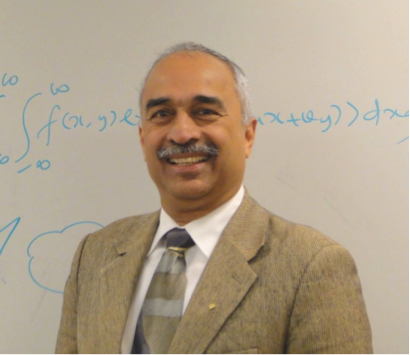 Rangaraj M. Rangayyan is a Professor of Electrical and Computer Engineering, and an Adjunct Professor of Surgery and Radiology, at the University of Calgary, Calgary, Alberta, Canada. He received the Bachelor of Engineering in Electronics and Communication in 1976 from the University of Mysore at the People's Education Society College of Engineering, Mandya, Karnataka, India, and the Ph.D. in Electrical Engineering from the Indian Institute of Science, Bangalore, Karnataka, India, in 1980. His research interests are in digital signal and image processing, biomedical signal and image analysis, and computer-aided diagnosis. He has published more than 160 papers in journals and 270 papers in proceedings of conferences. He has been recognized with the 1997 and 2001 Research Excellence Awards of the Department of Electrical and Computer Engineering, the 1997 Research Award of the Faculty of Engineering, and by appointment as "University Professor" (2003-2013) at the University of Calgary. He is the author of two textbooks: "Biomedical Signal Analysis" (IEEE/ Wiley, 2002, 2015) and "Biomedical Image Analysis" (CRC, 2005). He has coauthored and coedited several other books, including "Color Image Processing with Biomedical Applications" (SPIE, 2011). He has been recognized with the 2013 IEEE Canada Outstanding Engineer Medal, the IEEE Third Millennium Medal (2000), and elected as Fellow, IEEE (2001); Fellow, Engineering Institute of Canada (2002); Fellow, American Institute for Medical and Biological Engineering (2003); Fellow, SPIE (2003); Fellow, Society for Imaging Informatics in Medicine (2007); Fellow, Canadian Medical and Biological Engineering Society (2007); and Fellow, Canadian Academy of Engineering (2009).
Rangaraj M. Rangayyan is a Professor of Electrical and Computer Engineering, and an Adjunct Professor of Surgery and Radiology, at the University of Calgary, Calgary, Alberta, Canada. He received the Bachelor of Engineering in Electronics and Communication in 1976 from the University of Mysore at the People's Education Society College of Engineering, Mandya, Karnataka, India, and the Ph.D. in Electrical Engineering from the Indian Institute of Science, Bangalore, Karnataka, India, in 1980. His research interests are in digital signal and image processing, biomedical signal and image analysis, and computer-aided diagnosis. He has published more than 160 papers in journals and 270 papers in proceedings of conferences. He has been recognized with the 1997 and 2001 Research Excellence Awards of the Department of Electrical and Computer Engineering, the 1997 Research Award of the Faculty of Engineering, and by appointment as "University Professor" (2003-2013) at the University of Calgary. He is the author of two textbooks: "Biomedical Signal Analysis" (IEEE/ Wiley, 2002, 2015) and "Biomedical Image Analysis" (CRC, 2005). He has coauthored and coedited several other books, including "Color Image Processing with Biomedical Applications" (SPIE, 2011). He has been recognized with the 2013 IEEE Canada Outstanding Engineer Medal, the IEEE Third Millennium Medal (2000), and elected as Fellow, IEEE (2001); Fellow, Engineering Institute of Canada (2002); Fellow, American Institute for Medical and Biological Engineering (2003); Fellow, SPIE (2003); Fellow, Society for Imaging Informatics in Medicine (2007); Fellow, Canadian Medical and Biological Engineering Society (2007); and Fellow, Canadian Academy of Engineering (2009).
Mathematics of Deep Learning
Raja Giryes (Tel Aviv University)
Abstract: In the past five years there have seen a dramatic increase in the performance of recognition systems due to the introduction of deep neural networks for feature learning and classification. However, the theoretical foundation for this success remain elusive. This tutorial will present some of the theoretical results developed for deep neural networks that aim to provide a mathematical justification for properties such as the approximation capabilities, convergence, global optimality, invariance, stability of the learned representations, generalization error, etc. In addition, it will discuss the implication of the developed theory on practical training of neural networks.
The tutorial will start with the theory for neural networks from the early 90s (including the well-known results of Hornik et. al. and Cybenko).Then it will move to the recent theoretical findings established for deep learning in the past five year. The practical considerations that follow from the theory will be also discussed.
Brief biography of presenter
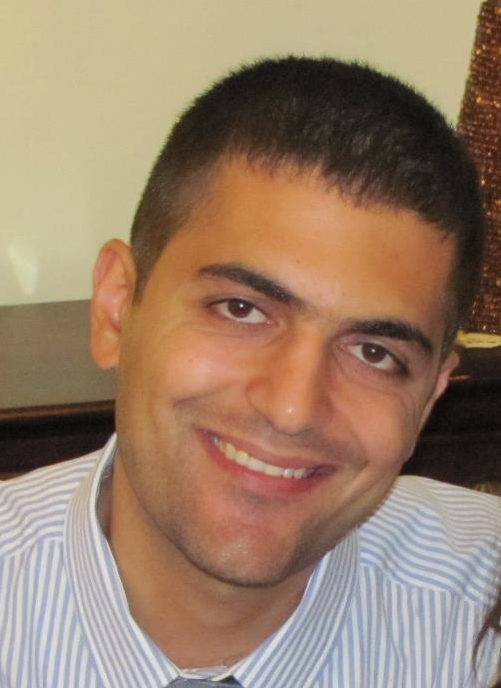 Raja Giryes is an assistant professor in the school of electrical engineering at Tel Aviv University. He received the B.Sc (2007), M.Sc. (supervision by Prof. M. Elad and Prof. Y. C. Eldar, 2009), and PhD (supervision by Prof. M. Elad 2014) degrees from the Department of Computer Science, The Technion - Israel Institute of Technology, Haifa. Raja was a postdoc at the computer science department at the Technion (Nov. 2013 till July 2014) and at the lab of Prof. G. Sapiro at Duke University, Durham, USA (July 2014 and Aug. 2015). His research interests lie at the intersection between signal and image processing and machine learning, and in particular, in deep learning, inverse problems, sparse representations, and signal and image modeling. Raja received the Maof prize for excellent young faculty (2016-2019), VATAT scholarship for excellent postdoctoral fellows (2014-2015), Intel Research and Excellence Award (2005, 2013), the Excellence in Signal Processing Award (ESPA) from Texas Instruments (2008) and was part of the Azrieli Fellows program (2010-2013).
Raja Giryes is an assistant professor in the school of electrical engineering at Tel Aviv University. He received the B.Sc (2007), M.Sc. (supervision by Prof. M. Elad and Prof. Y. C. Eldar, 2009), and PhD (supervision by Prof. M. Elad 2014) degrees from the Department of Computer Science, The Technion - Israel Institute of Technology, Haifa. Raja was a postdoc at the computer science department at the Technion (Nov. 2013 till July 2014) and at the lab of Prof. G. Sapiro at Duke University, Durham, USA (July 2014 and Aug. 2015). His research interests lie at the intersection between signal and image processing and machine learning, and in particular, in deep learning, inverse problems, sparse representations, and signal and image modeling. Raja received the Maof prize for excellent young faculty (2016-2019), VATAT scholarship for excellent postdoctoral fellows (2014-2015), Intel Research and Excellence Award (2005, 2013), the Excellence in Signal Processing Award (ESPA) from Texas Instruments (2008) and was part of the Azrieli Fellows program (2010-2013).
Tülay Adalı (University of Maryland), Dana Lahat (GIPSA Lab, Grenoble, France), Christian Jutten (GIPSA Lab, Grenoble, France)
Abstract: Fusion of multiple sets of data, either of the same type as in multiset data or of different types and nature as in multi-modality data, is inherent to many problems in engineering and computer science. In data fusion, since most often, very little is known about the relationship of the underlying processes that give rise to such data, it is desirable to minimize the modeling assumptions in such studies, and at the same time, to maximally exploit the interactions within and across the multiple sets of data. This is one of the reasons for the growing importance of data-driven methods in data fusion tasks. Models based on (possibly coupled) matrix or tensor decompositions allow data sets to remain in their most explanatory form while admitting a broad range of assumptions and links among their elements. A key concept in such decompositions, and in particular, when information from multiple sets of observations (matrices or tensors) is to be analyzed/fused is that of "diversity". Diversity refers to any structural, numerical, or statistical inherent property or assumption on the data that contributes to the identifiability of the model. In the presence of multiple datasets, diversity establishes the link among them and is thus the key and enabling factor to data fusion. In this tutorial, we concentrate on the key concept of diversity as the main enabling factor, and introduce the main theoretical concepts for data fusion with focus on source separation while also providing practitioners with guidance so that they can identify the "sources of diversity" for their given problem, and thus, design or identify the most suitable model and method.
Brief biography of presenters
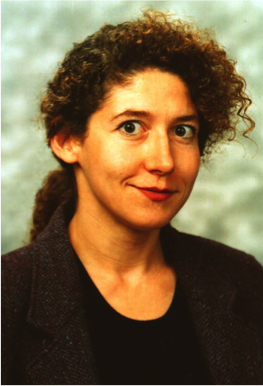 Tülay Adalı received the Ph.D. degree in Electrical Engineering from North Carolina State University, Raleigh, NC, USA, in 1992 and joined the faculty at the University of Maryland Baltimore County (UMBC), Baltimore, MD, USA, the same year. She is currently a Distinguished University Professor in the Department of Computer Science and Electrical Engineering at UMBC. Prof. Adalı has been very active in conference and workshop organizations. She was the general or technical co-chair of the IEEE Machine Learning for Signal Processing (MLSP) and Neural Networks for Signal Processing Workshops 2001–2008, and helped organize a number of conferences including the IEEE International Conference on Acoustics, Speech, and Signal Processing (ICASSP). She chaired the IEEE Signal Processing Society (SPS) MLSP Technical Committee (2003–2005, 2011–2013), IEEE Signal Processing Theory and Methods Technical Committee (2010–2015), served on the SPS Conference Board (1998–2006), and the Bio Imaging and Signal Processing Technical Committee (2004–2007). She was an Associate Editor for IEEE Transactions on Signal Processing (2003–2006), IEEE Transactions on Biomedical Engineering (2007–2013), IEEE Journal of Selected Areas in Signal Processing (2010–2013), and Elsevier Signal Processing Journal (2007–2010). She is currently serving on the Editorial Boards of the IEEE Proceedings and the Journal of Signal Processing Systems. Prof. Adali is a Fellow of the IEEE and the AIMBE, recipient of a 2010 IEEE Signal Processing Society Best Paper Award, 2013 University System of Maryland Regents' Award for Research, and an NSF CAREER Award. She was an IEEE Signal Processing Society Distinguished Lecturer for 2012 and 2013 and a Fulbright Scholar in 2015 and Otto Mønsteds Professor in 2016.
Tülay Adalı received the Ph.D. degree in Electrical Engineering from North Carolina State University, Raleigh, NC, USA, in 1992 and joined the faculty at the University of Maryland Baltimore County (UMBC), Baltimore, MD, USA, the same year. She is currently a Distinguished University Professor in the Department of Computer Science and Electrical Engineering at UMBC. Prof. Adalı has been very active in conference and workshop organizations. She was the general or technical co-chair of the IEEE Machine Learning for Signal Processing (MLSP) and Neural Networks for Signal Processing Workshops 2001–2008, and helped organize a number of conferences including the IEEE International Conference on Acoustics, Speech, and Signal Processing (ICASSP). She chaired the IEEE Signal Processing Society (SPS) MLSP Technical Committee (2003–2005, 2011–2013), IEEE Signal Processing Theory and Methods Technical Committee (2010–2015), served on the SPS Conference Board (1998–2006), and the Bio Imaging and Signal Processing Technical Committee (2004–2007). She was an Associate Editor for IEEE Transactions on Signal Processing (2003–2006), IEEE Transactions on Biomedical Engineering (2007–2013), IEEE Journal of Selected Areas in Signal Processing (2010–2013), and Elsevier Signal Processing Journal (2007–2010). She is currently serving on the Editorial Boards of the IEEE Proceedings and the Journal of Signal Processing Systems. Prof. Adali is a Fellow of the IEEE and the AIMBE, recipient of a 2010 IEEE Signal Processing Society Best Paper Award, 2013 University System of Maryland Regents' Award for Research, and an NSF CAREER Award. She was an IEEE Signal Processing Society Distinguished Lecturer for 2012 and 2013 and a Fulbright Scholar in 2015 and Otto Mønsteds Professor in 2016.
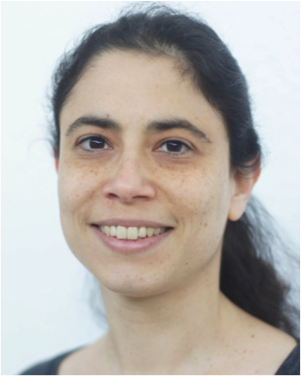 Dana Lahat received the BSc, MSc and PhD degrees in electrical and electronics engineering from Tel Aviv University, Israel, in 1998, 2004 and 2013, respectively. She is currently a postdoctoral researcher in GIPSA-Lab, Grenoble, France. She has been awarded the Chateaubriand Fellowship of the French Government for the academic year 2007–2008. Her main research interests are statistical and algebraic methods for signal processing and source separation.
Dana Lahat received the BSc, MSc and PhD degrees in electrical and electronics engineering from Tel Aviv University, Israel, in 1998, 2004 and 2013, respectively. She is currently a postdoctoral researcher in GIPSA-Lab, Grenoble, France. She has been awarded the Chateaubriand Fellowship of the French Government for the academic year 2007–2008. Her main research interests are statistical and algebraic methods for signal processing and source separation.
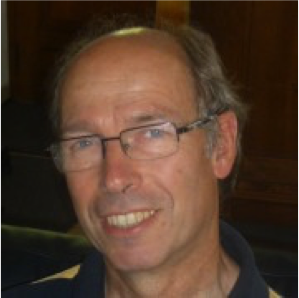 Christian Jutten received the PhD degree in 1981 and the Docteur ès Sciences degree in 1987 from the Institut National Polytechnique of Grenoble (France). He taught as associate professor in the Electrical Engineering Department from 1982 to 1989, before to become full professor in University Joseph Fourier of Grenoble. He was visiting professor in Swiss Federal Polytechnic Institute in Lausanne in 1989 and in University of Campinas (Brazil) in 2010. He has been deputy director of the Grenoble images, speech, signal and control laboratory (GIPSA, 300 people) and director of the Department Images-Signal (DIS, 100 people) from 2007 to 2010. For 30 years, his research interests are blind source separation, independent component analysis and learning in neural networks, including theoretical aspects (separability, source separation in nonlinear mixtures, sparsity) and applications in signal processing (biomedical, seismic, hyperspectral imaging, speech). He is author or co-author of more than 75 papers in international journals, four books, 25 invited plenary talks and 170 communications in international conferences. He has been associate editor of IEEE Trans. on Circuits and Systems (1994-95), and co-organizer the 1st International Conference on Blind Signal Separation and Independent Component Analysis (Aussois, France, January 1999). He has been a scientific advisor for signal and images processing at the French Ministry of Research from 1996 to 1998 and for the French National Research Center (CNRS) from 2003 to 2006. He is currently deputy director of Institute for Information Sciences and Technologies of CNRS. He received the Medal Blondel in 1997 from SEE (French Electrical Engineering society) for his contributions in source separation and independent component analysis, and has been elevated as a Fellow IEEE and a senior Member of Institut Universitaire de France in 2008. In 2012, he was awarded by an ERC Advanced Grant CHESS. In 2013, he has been elevated as EURASIP Fellow and reconducted for five years as a senior member of Institut Universitaire de France.
Christian Jutten received the PhD degree in 1981 and the Docteur ès Sciences degree in 1987 from the Institut National Polytechnique of Grenoble (France). He taught as associate professor in the Electrical Engineering Department from 1982 to 1989, before to become full professor in University Joseph Fourier of Grenoble. He was visiting professor in Swiss Federal Polytechnic Institute in Lausanne in 1989 and in University of Campinas (Brazil) in 2010. He has been deputy director of the Grenoble images, speech, signal and control laboratory (GIPSA, 300 people) and director of the Department Images-Signal (DIS, 100 people) from 2007 to 2010. For 30 years, his research interests are blind source separation, independent component analysis and learning in neural networks, including theoretical aspects (separability, source separation in nonlinear mixtures, sparsity) and applications in signal processing (biomedical, seismic, hyperspectral imaging, speech). He is author or co-author of more than 75 papers in international journals, four books, 25 invited plenary talks and 170 communications in international conferences. He has been associate editor of IEEE Trans. on Circuits and Systems (1994-95), and co-organizer the 1st International Conference on Blind Signal Separation and Independent Component Analysis (Aussois, France, January 1999). He has been a scientific advisor for signal and images processing at the French Ministry of Research from 1996 to 1998 and for the French National Research Center (CNRS) from 2003 to 2006. He is currently deputy director of Institute for Information Sciences and Technologies of CNRS. He received the Medal Blondel in 1997 from SEE (French Electrical Engineering society) for his contributions in source separation and independent component analysis, and has been elevated as a Fellow IEEE and a senior Member of Institut Universitaire de France in 2008. In 2012, he was awarded by an ERC Advanced Grant CHESS. In 2013, he has been elevated as EURASIP Fellow and reconducted for five years as a senior member of Institut Universitaire de France.
Network Localization and Navigation: from Theory to Practice
Moe Z. Win (LIDS, Massachusetts Institute of Technology, USA), Andrea Conti (ENDIF, University of Ferrara, Italy)
Abstract: The availability of real-time high-accuracy location awareness is essential for current and future wireless applications, particularly for the Internet of Things and 5G networks. Reliable localization and navigation is a critical component for a diverse set of applications including connected communities, smart cities, autonomous logistics, asset tracking, medical services, vehicle autonomy, military systems, as well as a large set of emerging wireless sensor network applications. The coming years will see the emergence of network localization and navigation in challenging environments with sub-meter accuracy and minimal infrastructure requirements.
We will first discuss the limitations of traditional positioning, and move on to the key enablers for high-accuracy location awareness: wideband transmission and cooperative processing. We will then cover three basic components: Fisher information inequality, ranging and positioning algorithms, and network experimentation in real environments. Fisher information inequality serves as fundamental performance limit for network design. Cooperative algorithms are a way to achieve drastic performance improvements with respect to traditional non-cooperative positioning. Network experimentation enables the comparison of different cooperative algorithms under a common setting. To this aim, we have performed extensive measurement campaigns with wideband radios.
Brief biography of presenters
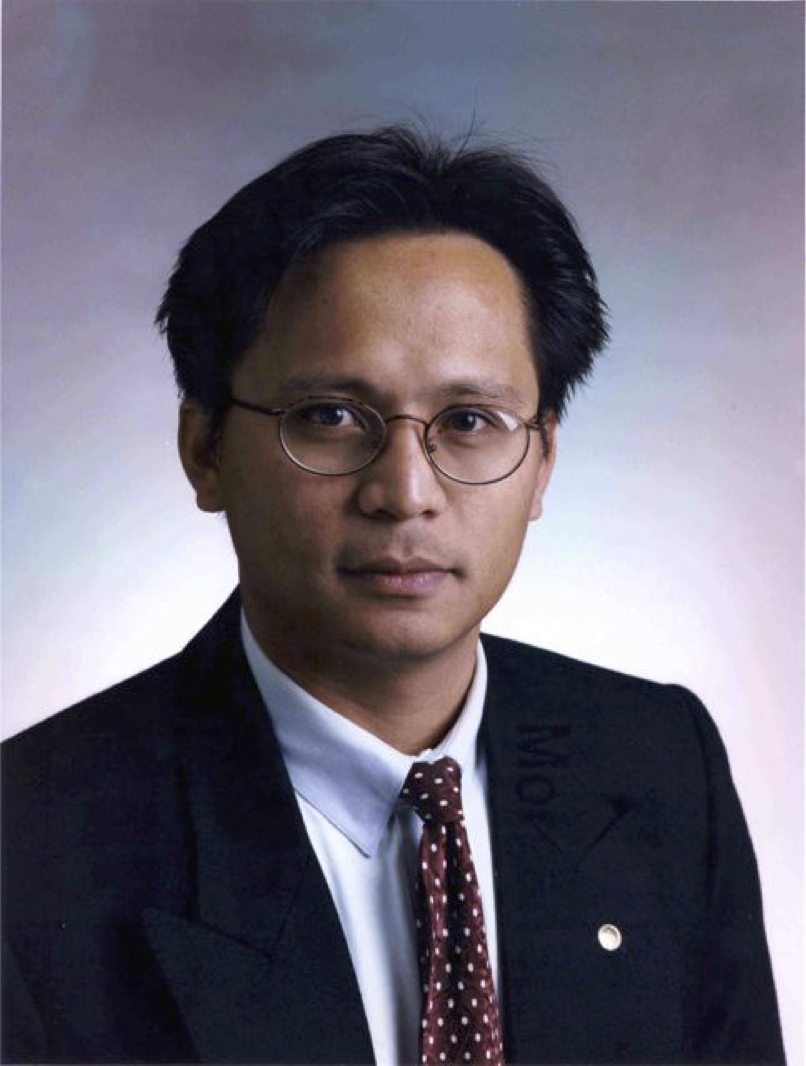 Moe Win is a Professor at the Massachusetts Institute of Technology (MIT). Prior to joining MIT, he was at AT&T Research Laboratories for five years and at the Jet Propulsion Laboratory for seven years. His research encompasses fundamental theories, algorithm design, and experimentation for a broad range of real-world problems. His current research topics include network localization and navigation, network interference exploitation, intrinsic wireless secrecy, adaptive diversity techniques, ultra-wide bandwidth systems, optical transmission systems, and space communications systems. Professor Win is an elected Member-at-Large on the IEEE Communications Society Board of Governors (2011−2013). He was the Chair (2005−2006) and Secretary (2003−2004) for the Radio Communications Committee of the IEEE Communications Society. Dr. Win is currently an Editor-at-Large for the WIRELESS COMMUNICATIONS LETTERS. He served as Editor (2006–2012) for the IEEE TRANSACTIONS ON WIRELESS COMMUNICATIONS, and as Area Editor (2003–2006) and Editor (1998–2006) for the IEEE TRANSACTIONS ON COMMUNICATIONS. He was honored with two IEEE Technical Field Awards: the IEEE Kiyo Tomiyasu Award and the IEEE Eric E. Sumner Award. He received the International Prize for Communications Cristoforo Colombo, Copernicus Fellowship, the Royal Academy of Engineering Distinguished Visiting Fellowship, the Fulbright Fellowship, the Laurea Honoris Causa from the University of Ferrara, the Technical Recognition Award of the IEEE Radio Communications Committee, and the U.S. Presidential Early Career Award for Scientists and Engineers. Professor Win is elected Fellow of the AAAS, the IEEE, and the IET, and was an IEEE Distinguished Lecturer.
Moe Win is a Professor at the Massachusetts Institute of Technology (MIT). Prior to joining MIT, he was at AT&T Research Laboratories for five years and at the Jet Propulsion Laboratory for seven years. His research encompasses fundamental theories, algorithm design, and experimentation for a broad range of real-world problems. His current research topics include network localization and navigation, network interference exploitation, intrinsic wireless secrecy, adaptive diversity techniques, ultra-wide bandwidth systems, optical transmission systems, and space communications systems. Professor Win is an elected Member-at-Large on the IEEE Communications Society Board of Governors (2011−2013). He was the Chair (2005−2006) and Secretary (2003−2004) for the Radio Communications Committee of the IEEE Communications Society. Dr. Win is currently an Editor-at-Large for the WIRELESS COMMUNICATIONS LETTERS. He served as Editor (2006–2012) for the IEEE TRANSACTIONS ON WIRELESS COMMUNICATIONS, and as Area Editor (2003–2006) and Editor (1998–2006) for the IEEE TRANSACTIONS ON COMMUNICATIONS. He was honored with two IEEE Technical Field Awards: the IEEE Kiyo Tomiyasu Award and the IEEE Eric E. Sumner Award. He received the International Prize for Communications Cristoforo Colombo, Copernicus Fellowship, the Royal Academy of Engineering Distinguished Visiting Fellowship, the Fulbright Fellowship, the Laurea Honoris Causa from the University of Ferrara, the Technical Recognition Award of the IEEE Radio Communications Committee, and the U.S. Presidential Early Career Award for Scientists and Engineers. Professor Win is elected Fellow of the AAAS, the IEEE, and the IET, and was an IEEE Distinguished Lecturer.
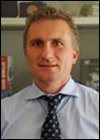 Andrea Conti is an Associate Professor at the University of Ferrara. He was with CNIT (1999–2002) and IEIIT/CNR (2002–2005) at the Research Unit of Bologna. In Summer 2001, he was with the Wireless Systems Research Department at AT&T Research Laboratories. Since 2003, he has been a frequent visitor to the Wireless Information and Network Sciences Laboratory at the Massachusetts Institute of Technology (MIT), where he presently holds the Research Affiliate appointment. He is a coauthor of Wireless Sensor and Actuator Networks: Enabling Technologies, Information Processing and Protocol Design (Elsevier, 2008). His research interests involve theory and experimentation of wireless systems and networks including network localization, adaptive diversity communications, cooperative relaying techniques, and network secrecy. He is a recipient of the HTE Puskás Tivadar Medal and co-recipient of the IEEE Communications Society's Stephen O. Rice Prize and the IEEE Communications Society's Fred W. Ellersick Prize. Dr. Conti is is serving as an Editor for the IEEE WIRELESS COMMUNICATIONS LETTERS and served as an Associate Editor for the IEEE TRANSACTIONS ON WIRELESS COMMUNICATIONS and for the for the IEEE COMMUNICATIONS LETTERS. He organized and chaired a number of IEEE conferences. He was elected Chair (2013−2014), Vice-Chair (2011−2012), and Secretary (2009−2010) of the IEEE Communications Society's Radio Communications Technical Committee. He is an elected Fellow of the IET and has been selected as an IEEE Distinguished Lecturer.
Andrea Conti is an Associate Professor at the University of Ferrara. He was with CNIT (1999–2002) and IEIIT/CNR (2002–2005) at the Research Unit of Bologna. In Summer 2001, he was with the Wireless Systems Research Department at AT&T Research Laboratories. Since 2003, he has been a frequent visitor to the Wireless Information and Network Sciences Laboratory at the Massachusetts Institute of Technology (MIT), where he presently holds the Research Affiliate appointment. He is a coauthor of Wireless Sensor and Actuator Networks: Enabling Technologies, Information Processing and Protocol Design (Elsevier, 2008). His research interests involve theory and experimentation of wireless systems and networks including network localization, adaptive diversity communications, cooperative relaying techniques, and network secrecy. He is a recipient of the HTE Puskás Tivadar Medal and co-recipient of the IEEE Communications Society's Stephen O. Rice Prize and the IEEE Communications Society's Fred W. Ellersick Prize. Dr. Conti is is serving as an Editor for the IEEE WIRELESS COMMUNICATIONS LETTERS and served as an Associate Editor for the IEEE TRANSACTIONS ON WIRELESS COMMUNICATIONS and for the for the IEEE COMMUNICATIONS LETTERS. He organized and chaired a number of IEEE conferences. He was elected Chair (2013−2014), Vice-Chair (2011−2012), and Secretary (2009−2010) of the IEEE Communications Society's Radio Communications Technical Committee. He is an elected Fellow of the IET and has been selected as an IEEE Distinguished Lecturer.
High Dynamic Range Video
Erik Reinhard (Technicolor R&I), Giuseppe Valenzise (CNRS / Télécom ParisTech), Frédéric Dufaux (CNRS / Télécom ParisTech)
Abstract: Producing truly realistic video is widely seen as the holy grail towards further improving Quality of Experience (QoE) for emerging multimedia services. Currently investigated directions include high spatial resolutions, high frame rates, wide color gamut and high bit-depth rendering. The human visual system is able to perceive a wide range of colors and luminous intensities, as present in outdoor scenes in everyday real life, ranging from bright sunshine to dark shadows. However, current traditional imaging technologies cannot capture nor reproduce such a broad range of luminance. High dynamic range (HDR) imaging technologies enable the capture, processing and display of images containing a much wider range of illumination compared to traditional imaging solutions. To achieve this, all aspects of the imaging pipeline need to be rethought and redesigned, which has led to an active area of research.
In this tutorial, the focus is on the capture, processing and display of HDR video, presenting the state-of-the-art in hardware and software technologies and discussing the main challenges pertinent to this exciting field. This course is appropriate for students, researchers and practitioners with an interest in HDR imaging/video and specifically for those interested in understanding the practical aspects of the technology. The course will offer a balanced academic/industrial perspective on the state of this field. By providing a broad coverage, the tutorial is expected to be of interest to a wide audience with different backgrounds and expectations, with the ambition to offer a comprehensive understanding on several topics that encompass HDR video.
Brief biography of presenters
 Erik Reinhard is Distinguished Scientist at Technicolor R&I since July 2013 prior to holding various academic positions at universities and research institutes in Europe and North America. He was founder and editor-in-chief of ACM Transactions on Applied Perception, and authored books on high dynamic range imaging, color imaging, computer graphics and natural image statistics. He enjoys research that spans different disciplines, including color science, high dynamic range imaging and human visual perception. He has published more than 100 papers in these areas, and was member of more than 50 program committees. He was program co-chair of 6 conferences and workshops, including the Eurographics Symposium on Rendering 2011. He delivered key notes at Eurographics 2010, the Computational Color Imaging Workshop 2011, and the IS\&T European Conference on Colour in Graphics, Imaging and Vision 2012. He has been a speaker in more than 15 courses and tutorials, of which 10 were delivered at SIGGRAPH.
Erik Reinhard is Distinguished Scientist at Technicolor R&I since July 2013 prior to holding various academic positions at universities and research institutes in Europe and North America. He was founder and editor-in-chief of ACM Transactions on Applied Perception, and authored books on high dynamic range imaging, color imaging, computer graphics and natural image statistics. He enjoys research that spans different disciplines, including color science, high dynamic range imaging and human visual perception. He has published more than 100 papers in these areas, and was member of more than 50 program committees. He was program co-chair of 6 conferences and workshops, including the Eurographics Symposium on Rendering 2011. He delivered key notes at Eurographics 2010, the Computational Color Imaging Workshop 2011, and the IS\&T European Conference on Colour in Graphics, Imaging and Vision 2012. He has been a speaker in more than 15 courses and tutorials, of which 10 were delivered at SIGGRAPH.
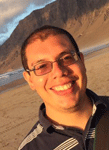 Giuseppe Valenzise is a CNRS researcher at Telecom ParisTech, Paris, since October 2012. Previously, he worked as post-doc researcher in the same lab, starting from July 2011. He completed a master degree and a Ph.D. in Information Technology at the Politecnico di Milano in 2007 and 2011, respectively. From January 2009 to July 2009 he was a visiting scholar at the Signal and Image Processing Institute (SIPI) at the University of Southern California. His research interests span different fields of image and video processing, including single and multi-view video coding, high-dynamic range imaging, video quality assessment, video surveillance, image and video forensics, image and video analysis. He is co-author of more than 40 research publications.
Giuseppe Valenzise is a CNRS researcher at Telecom ParisTech, Paris, since October 2012. Previously, he worked as post-doc researcher in the same lab, starting from July 2011. He completed a master degree and a Ph.D. in Information Technology at the Politecnico di Milano in 2007 and 2011, respectively. From January 2009 to July 2009 he was a visiting scholar at the Signal and Image Processing Institute (SIPI) at the University of Southern California. His research interests span different fields of image and video processing, including single and multi-view video coding, high-dynamic range imaging, video quality assessment, video surveillance, image and video forensics, image and video analysis. He is co-author of more than 40 research publications.
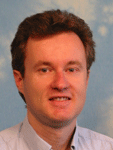 Frederic Dufaux is a CNRS Research Director at Telecom ParisTech. He is also Editor-in-Chief of Signal Processing: Image Communication. Frederic received his M.Sc. in physics and Ph.D. in electrical engineering from EPFL in 1990 and 1994 respectively. He has over 20 years of experience in research, previously holding positions at EPFL, Emitall Surveillance, Genimedia, Compaq, Digital Equipment, MIT, and Bell Labs. He has been involved in the standardization of digital video and imaging technologies, participating both in the MPEG and JPEG committees. He is the recipient of two ISO awards for his contributions. Frederic is a Fellow of IEEE. He was Vice General Chair of ICIP 2014. He is an elected member of the IEEE Image, Video, and Multidimensional Signal Processing (IVMSP) and Multimedia Signal Processing (MMSP) Technical Committees. He is also the Chair of the EURASIP Special Area Team on Visual Information Processing. His research interests include image and video coding, high dynamic range imaging, distributed video coding, 3D video, visual quality assessment, video surveillance, privacy protection, image and video analysis, multimedia content search and retrieval, and video transmission over wireless network. He is the author or co-author of more than 120 research publications and holds 17 patents issued or pending.
Frederic Dufaux is a CNRS Research Director at Telecom ParisTech. He is also Editor-in-Chief of Signal Processing: Image Communication. Frederic received his M.Sc. in physics and Ph.D. in electrical engineering from EPFL in 1990 and 1994 respectively. He has over 20 years of experience in research, previously holding positions at EPFL, Emitall Surveillance, Genimedia, Compaq, Digital Equipment, MIT, and Bell Labs. He has been involved in the standardization of digital video and imaging technologies, participating both in the MPEG and JPEG committees. He is the recipient of two ISO awards for his contributions. Frederic is a Fellow of IEEE. He was Vice General Chair of ICIP 2014. He is an elected member of the IEEE Image, Video, and Multidimensional Signal Processing (IVMSP) and Multimedia Signal Processing (MMSP) Technical Committees. He is also the Chair of the EURASIP Special Area Team on Visual Information Processing. His research interests include image and video coding, high dynamic range imaging, distributed video coding, 3D video, visual quality assessment, video surveillance, privacy protection, image and video analysis, multimedia content search and retrieval, and video transmission over wireless network. He is the author or co-author of more than 120 research publications and holds 17 patents issued or pending.
Rethinking Fourier Acoustics
Augusto Sarti (DEIB – Politecnico di Milano, Italy), Fabio Antonacci (DEIB – Politecnico di Milano, Italy), Lucio Bianchi (DEIB – Politecnico di Milano, Italy)
Abstract: The literature of acoustic signal processing tends to rely on divide-and-conquer strategies derived from Fourier Acoustics, therefore it tends to inherit the limits that such a representation entails, in terms of resolution, frequency and far-field operation. In this tutorial we would like to explore whether there are viable alternatives to this choice.
We begin with exploring Fourier-inspired soundfield processing tools such as Plane-Wave Decomposition (PWD) and Spherical Harmonics Decomposition (SHD), and related applications. We also discuss various solutions for overcoming the inherent limitations of such signal decomposition/processing tools, based on modeling generalizations; spatial divide-and-conquer strategies; domain relocations, etc. We will see that, in order to truly overcome the inherent limitations of Fourier Acoustics, we need to rethink our analysis approach and, in particular, our signal decomposition strategy. This we do by introducing a novel wave-field decomposition methodology based on Gabor frames, which is more suitable for local (in the space-time domain) representations. Based on this new framework for computational acoustics, we define the plenacoustic (ray-space) transform and its conditions of invertibility, and we show how this new instrument can be used for efficiently and effectively approaching a far wider range of problems, ranging from simple source separation; to environment shape inference; to swift object-based manipulation of acoustic wavefields.
This tutorial is divided into three parts. In the former we offer an overview of conventional wave-field decomposition strategies, as derived from Fourier Acoustics. In the second part we push the boundaries of these tools through various generalization strategies. In the latter we introduce an example of wave-field representation and decomposition strategy based on Gabor frames, and we show how to develop analysis and rendering solutions based on this representation. In each one of the three parts we introduce and discuss examples of application, and compare approaches.
Brief biography of presenters
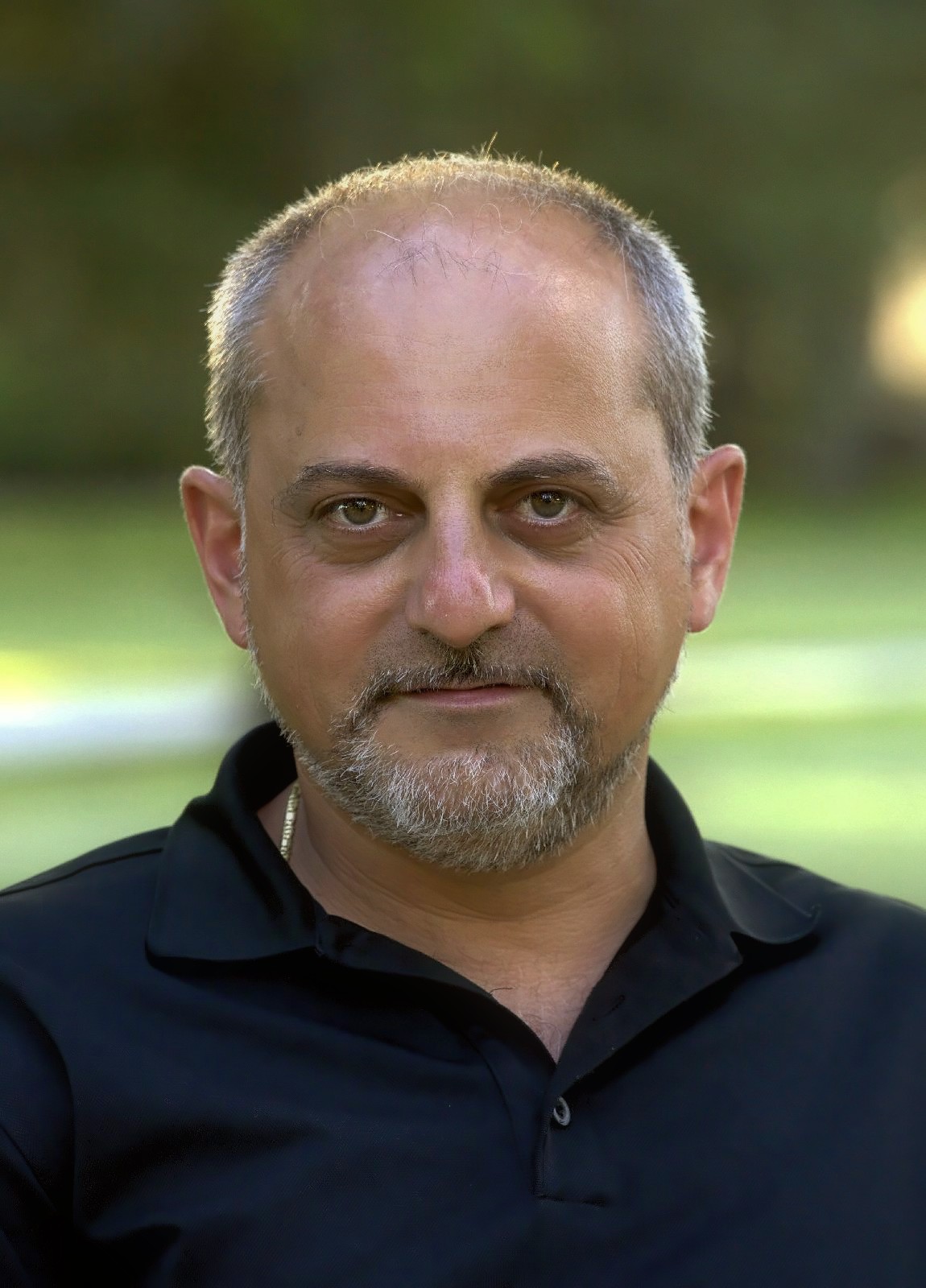 Augusto Sarti received the M.S. and the Ph.D. degrees in electronic engineering, both from the University of Padua, Italy, in 1988 and 1993, respectively. His graduate studies included a joint graduate program with the University of California, Berkeley. In 1993, he joined the Politecnico di Milano, Milan, Italy, where he is currently an Associate Professor. In 2013, he also joined the University of California, Davis, as an Adjunct Professor. His research interests are in the area of multimedia signal processing, with particular focus on audio and acoustic signal processing. He also worked on problems of multidimensional signal processing, 3D vision and nonlinear systems. He coauthored over 250 scientific publications on international journals and congresses as well as numerous patents in the multimedia signal processing area. He coordinates the activities of the Musical Acoustics Lab and of the Sound and Music Computing Lab of the Politecnico di Milano. He promoted and coordinated or contributed to numerous (20+) European projects. He is a member of the IEEE Technical Committee on Audio and Acoustics Signal Processing, and the chairman of the EURASIP Special Area Team (SAT) on Acoustic, Sound and Music Signal Processing (ASMSP). He has served as area chair of Audio and Acoustics for past editions of EUSIPCO. He was co-chairman of the 2005 Edition of the IEEE International Conference on Advanced Video and Signal based Surveillance (AVSS); Chairman of 2009 edition of the Digital Audio Effects conference, (DAFx); and in the organizing committees of numerous other conferences in the area of multimedia signal processing. He is currently Associate Editor and Senior Area Editor of IEEE Tr. Audio Speech and Language Processing and Signal Processing Letters, respectively.
Augusto Sarti received the M.S. and the Ph.D. degrees in electronic engineering, both from the University of Padua, Italy, in 1988 and 1993, respectively. His graduate studies included a joint graduate program with the University of California, Berkeley. In 1993, he joined the Politecnico di Milano, Milan, Italy, where he is currently an Associate Professor. In 2013, he also joined the University of California, Davis, as an Adjunct Professor. His research interests are in the area of multimedia signal processing, with particular focus on audio and acoustic signal processing. He also worked on problems of multidimensional signal processing, 3D vision and nonlinear systems. He coauthored over 250 scientific publications on international journals and congresses as well as numerous patents in the multimedia signal processing area. He coordinates the activities of the Musical Acoustics Lab and of the Sound and Music Computing Lab of the Politecnico di Milano. He promoted and coordinated or contributed to numerous (20+) European projects. He is a member of the IEEE Technical Committee on Audio and Acoustics Signal Processing, and the chairman of the EURASIP Special Area Team (SAT) on Acoustic, Sound and Music Signal Processing (ASMSP). He has served as area chair of Audio and Acoustics for past editions of EUSIPCO. He was co-chairman of the 2005 Edition of the IEEE International Conference on Advanced Video and Signal based Surveillance (AVSS); Chairman of 2009 edition of the Digital Audio Effects conference, (DAFx); and in the organizing committees of numerous other conferences in the area of multimedia signal processing. He is currently Associate Editor and Senior Area Editor of IEEE Tr. Audio Speech and Language Processing and Signal Processing Letters, respectively.
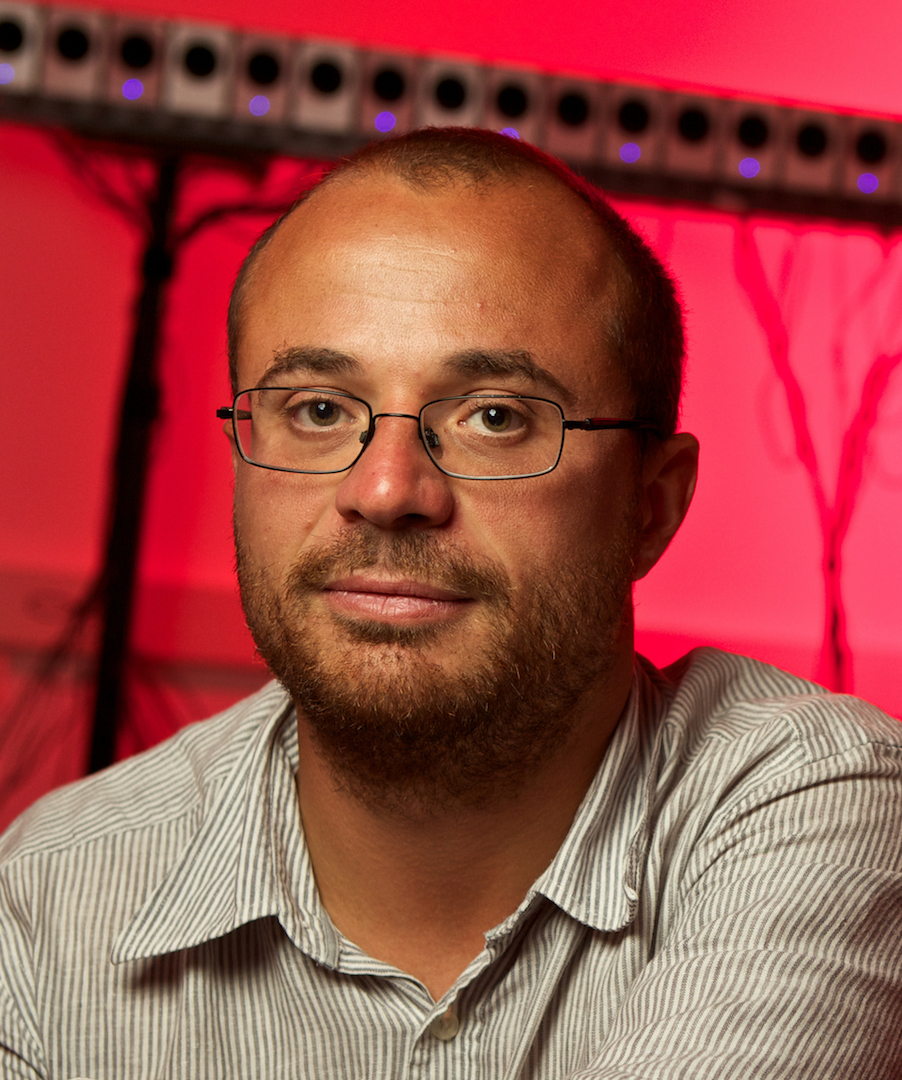 Fabio Antonacci received his "Laurea" (BS+MS) degree in 2004 and his Ph.D. in 2008, from the Politecnico di Milano, Italy. He has been with DEIB - Politecnico di Milano since then, first as a Post-Doctoral researcher, then (in 2014) as an assistant professor. His research interests are in acoustic scene analysis and rendering through microphone and loudspeaker arrays, with particular focus on source localization/tracking, reflector localization, estimation of acoustic parameters, rendering of the acoustics of virtual environments using wavefield synthesis techniques. He has authored over 70 journal and conference papers on these topics, and is currently a member of the EURASIP Special Area Team (SAT) on Acoustic, Sound and Music Signal Processing (ASMSP).
Fabio Antonacci received his "Laurea" (BS+MS) degree in 2004 and his Ph.D. in 2008, from the Politecnico di Milano, Italy. He has been with DEIB - Politecnico di Milano since then, first as a Post-Doctoral researcher, then (in 2014) as an assistant professor. His research interests are in acoustic scene analysis and rendering through microphone and loudspeaker arrays, with particular focus on source localization/tracking, reflector localization, estimation of acoustic parameters, rendering of the acoustics of virtual environments using wavefield synthesis techniques. He has authored over 70 journal and conference papers on these topics, and is currently a member of the EURASIP Special Area Team (SAT) on Acoustic, Sound and Music Signal Processing (ASMSP).
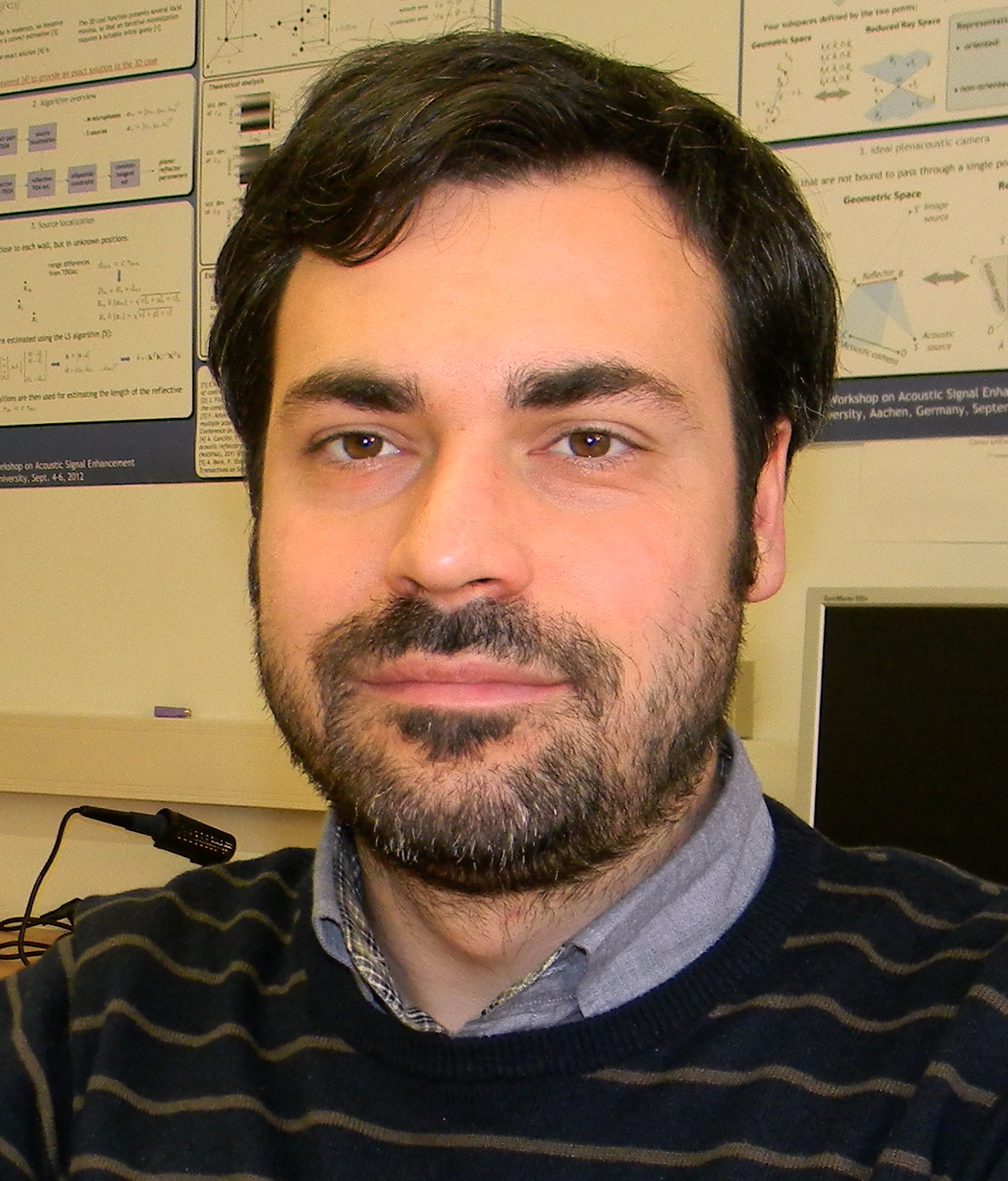 Lucio Bianchi received his B.Sc. in Electronic Engineering (2010), the M.Sc. in Computer Engineering (2012), and the Ph.D. in Information Technology (2016) from Politecnico di Milano, Milan, Italy. He then joined the Dept. of Electronics, Information and Bioengineering of the Politecnico di Milano as a Post-Doctoral researcher. His research interests are mainly on applications of signal processing to acoustics, with special emphasis on acoustic scene analysis and rendering based on microphone and loudspeaker arrays, and plenacoustic processing.
Lucio Bianchi received his B.Sc. in Electronic Engineering (2010), the M.Sc. in Computer Engineering (2012), and the Ph.D. in Information Technology (2016) from Politecnico di Milano, Milan, Italy. He then joined the Dept. of Electronics, Information and Bioengineering of the Politecnico di Milano as a Post-Doctoral researcher. His research interests are mainly on applications of signal processing to acoustics, with special emphasis on acoustic scene analysis and rendering based on microphone and loudspeaker arrays, and plenacoustic processing.
Energy-Neutral System-Level Analysis and Optimization of 5G Wireless Networks
Alessio Zappone (Technische Universitat Dresden, Germany), Marco Di Renzo (Paris-Saclay University), Eduard Jorswieck (Technische Universitat Dresden, Germany)
Abstract: The Internet of Things (IoT) will connect billions of devices by 2020. Such systems suppose batteries and/or energy harvesting from the environment, which also bets for very low energy devices. In order to enable IoT service capabilities, 5G wireless networks will need to bring a drastic energy efficiency improvement and will need to develop energy harvesting capabilities. This energy chase will cover low-energy devices and network elements, and will rely on the availability of renewable energy sources, dedicated power sources, as well as the possibility of harvesting energy directly from the radio waves that are primarily used for data transmission. This leads to a new design space, where the availability of energy is not deterministic anymore but may depend on environmental factors, the interference may not necessarily be harmful as it may be a natural source electromagnetic-based power to be used for replenishing the batteries of low-energy devices, and the intended signals may be exploited for both data transmission and energy harvesting. This paradigm-shift introduces a new concept in the design of 5G wireless networks: energy-neutrality. Energy-neutral networks are systems that not only make an efficient use of the available energy, but, more importantly, that operate in a complete self-powered fashion.
The present tutorial provides the audience with a complete survey of the potential benefits, research challenges, implementation efforts and application of technologies and protocols for achieving energy-neutrality, as well as the mathematical tools for their modeling, analysis and optimization. This tutorial is unique of its kind, as it tackles both system-level modeling and optimization aspects, which are usually treated independently. Special focus will be put on two methodologies for enabling the system-level modeling and the system-level and distributed optimization of energy-neutral 5G wireless networks: stochastic geometry and fractional programming. In the proposed tutorial, we illustrate how several candidate transmission technologies, communication protocols, and network architectures for 5G can be modeled, studied, optimized, and compared for their energy-neutral operation.
Brief biography of presenters
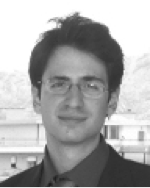 Dr. Alessio Zappone was born in 1982 in Rome, Italy. He obtained his Master degree in telecommunication engineering and his Ph.D. degree in electrical engineering in 2007 and 2011, respectively, from the Universita' degli Studi di Cassino e del Lazio Meriodionale, Cassino, Italy. His Ph.D. studies were focused on distributed algorithms for energy-efficient resource allocation in wireless networks. After obtaining his Ph.D. Alessio worked as a Post-doc researcher with CNIT (Consorzio Nazionale Interuniversitario per le Telecomunicazioni) until 2012, working on both centralized and distributed energy efficiency optimization in the framework of the FP7 EU-funded project TREND. Since October 2012, Alessio is with the Technische Universitat Dresden, managing the project CEMRIN on energy-efficient resource allocation in wireless networks, funded by the German research foundation (DFG). Since 2015, Alessio serves as Associate Editor of the IEEE Signal Processing Letters, and he is a Guest Editor of the IEEE JSAC Special issue on "Energy-Efficient Techniques for 5G Wireless Communication Systems". Alessio's research interests lie in the area of communication networks and signal processing, with main focus on resource allocation techniques for energy efficiency optimization.
Dr. Alessio Zappone was born in 1982 in Rome, Italy. He obtained his Master degree in telecommunication engineering and his Ph.D. degree in electrical engineering in 2007 and 2011, respectively, from the Universita' degli Studi di Cassino e del Lazio Meriodionale, Cassino, Italy. His Ph.D. studies were focused on distributed algorithms for energy-efficient resource allocation in wireless networks. After obtaining his Ph.D. Alessio worked as a Post-doc researcher with CNIT (Consorzio Nazionale Interuniversitario per le Telecomunicazioni) until 2012, working on both centralized and distributed energy efficiency optimization in the framework of the FP7 EU-funded project TREND. Since October 2012, Alessio is with the Technische Universitat Dresden, managing the project CEMRIN on energy-efficient resource allocation in wireless networks, funded by the German research foundation (DFG). Since 2015, Alessio serves as Associate Editor of the IEEE Signal Processing Letters, and he is a Guest Editor of the IEEE JSAC Special issue on "Energy-Efficient Techniques for 5G Wireless Communication Systems". Alessio's research interests lie in the area of communication networks and signal processing, with main focus on resource allocation techniques for energy efficiency optimization.
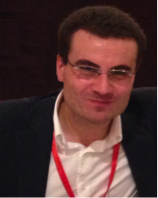 Dr. Marco Di Renzo was born in L'Aquila, Italy, in 1978. He received the Laurea (cum laude) and the Ph.D. degrees in Electrical and Information Engineering from the Department of Electrical and Information Engineering, University of L'Aquila, Italy, in April 2003 and in January 2007, respectively. In October 2013, he received the Habilitation à Diriger des Recherches (Doctor of Science) degree from the University Paris-Sud, Paris, France. He has held various research and academic positions in Italy at the University of L'Aquila, in the USA at Virginia Tech, in Spain at CTTC, and in the UK at The University of Edinburgh. Since 2010, he has been a CNRS Associate Professor ("Chargé de Recherche Titulaire CNRS") in the Laboratory of Signals and Systems of Paris-Saclay University – CNRS, CentraleSupélec, Univ Paris Sud, France. He is a Distinguished Visiting Fellow of the Royal Academy of Engineering, UK. He is a co-founder of the university spin-off company WEST Aquila s.r.l., Italy. Dr. Di Renzo is the recipient of a special mention for the outstanding five-year (1997-2003) academic career, University of L'Aquila, Italy; the THALES Communications fellowship (2003-2006), University of L'Aquila, Italy; the 2004 Best Spin-Off Company Award, Abruzzo Province, Italy; the 2008 Torres Quevedo Award, Ministry of Science and Innovation, Spain; the "Dérogation pour l'Encadrement de Thèse" (2010), University of Paris-Sud, France; the 2012 IEEE CAMAD Best Paper Award; the 2012 IEEE WIRELESS COMMUNICATIONS LETTERS Exemplary Reviewer Certificate; the 2013 IEEE VTC-Fall Best Student Paper Award; the 2013 Network of Excellence NEWCOM# Best Paper Award; the 2013 IEEE TRANSACTIONS ON VEHICULAR TECHNOLOGY Top Reviewer Award; the 2013 IEEE-COMSOC Best Young Researcher Award for Europe, Middle East and Africa (EMEA Region); the 2014 Royal Academy of Engineering Distinguished Visiting Fellowship, United Kingdom; the 2014 IEEE ATC Best Paper Award; the 2014 IEEE CAMAD Best Demo Award; the 2014 IEEE CAMAD Best Paper Award; the 2014 IEEE WIRELESS COMMUNICATIONS LETTERS Exemplary Reviewer Certificate, the 2015 IEEE ComManTel Best Paper Award; the 2015 IEEE Jack Neubauer Memorial Award; and the 2015-2018 CNRS Award for Excellence in Research and in Advising Doctoral Students. Currently, he serves as an Editor of the IEEE COMMUNICATIONS LETTERS and of the IEEE TRANSACTIONS ON COMMUNICATIONS (Heterogeneous Networks Modeling and Analysis). He is a Senior Member of the IEEE and COMSOC, and a Member of the European Association for Communications and Networking (EURACON).
Dr. Marco Di Renzo was born in L'Aquila, Italy, in 1978. He received the Laurea (cum laude) and the Ph.D. degrees in Electrical and Information Engineering from the Department of Electrical and Information Engineering, University of L'Aquila, Italy, in April 2003 and in January 2007, respectively. In October 2013, he received the Habilitation à Diriger des Recherches (Doctor of Science) degree from the University Paris-Sud, Paris, France. He has held various research and academic positions in Italy at the University of L'Aquila, in the USA at Virginia Tech, in Spain at CTTC, and in the UK at The University of Edinburgh. Since 2010, he has been a CNRS Associate Professor ("Chargé de Recherche Titulaire CNRS") in the Laboratory of Signals and Systems of Paris-Saclay University – CNRS, CentraleSupélec, Univ Paris Sud, France. He is a Distinguished Visiting Fellow of the Royal Academy of Engineering, UK. He is a co-founder of the university spin-off company WEST Aquila s.r.l., Italy. Dr. Di Renzo is the recipient of a special mention for the outstanding five-year (1997-2003) academic career, University of L'Aquila, Italy; the THALES Communications fellowship (2003-2006), University of L'Aquila, Italy; the 2004 Best Spin-Off Company Award, Abruzzo Province, Italy; the 2008 Torres Quevedo Award, Ministry of Science and Innovation, Spain; the "Dérogation pour l'Encadrement de Thèse" (2010), University of Paris-Sud, France; the 2012 IEEE CAMAD Best Paper Award; the 2012 IEEE WIRELESS COMMUNICATIONS LETTERS Exemplary Reviewer Certificate; the 2013 IEEE VTC-Fall Best Student Paper Award; the 2013 Network of Excellence NEWCOM# Best Paper Award; the 2013 IEEE TRANSACTIONS ON VEHICULAR TECHNOLOGY Top Reviewer Award; the 2013 IEEE-COMSOC Best Young Researcher Award for Europe, Middle East and Africa (EMEA Region); the 2014 Royal Academy of Engineering Distinguished Visiting Fellowship, United Kingdom; the 2014 IEEE ATC Best Paper Award; the 2014 IEEE CAMAD Best Demo Award; the 2014 IEEE CAMAD Best Paper Award; the 2014 IEEE WIRELESS COMMUNICATIONS LETTERS Exemplary Reviewer Certificate, the 2015 IEEE ComManTel Best Paper Award; the 2015 IEEE Jack Neubauer Memorial Award; and the 2015-2018 CNRS Award for Excellence in Research and in Advising Doctoral Students. Currently, he serves as an Editor of the IEEE COMMUNICATIONS LETTERS and of the IEEE TRANSACTIONS ON COMMUNICATIONS (Heterogeneous Networks Modeling and Analysis). He is a Senior Member of the IEEE and COMSOC, and a Member of the European Association for Communications and Networking (EURACON).
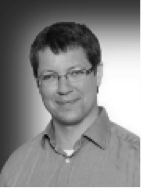 Prof. Eduard A. Jorswieck was born in 1975 in Berlin, Germany. He received his Diplom-Ingenieur (M.S.) degree and Doktor-Ingenieur (Ph.D.) degree, both in electrical engineering and computer science from the Technische Universitat Berlin, Germany, in 2000 and 2004, respectively. He was with the Fraunhofer Institute for Telecommunications, Heinrich-Hertz-Institut (HHI) Berlin, in the Broadband Mobile Communication Networks Department from December 2000 to February 2008. From April 2005 until February 2008, he was a lecturer at the Technische Universitat Berlin. From February 2006 until February 2008, he worked for the Department of Signals, Sensors and Systems at the Royal Institute of Technology (KTH) as a post-doc and Assistant Professor. Since February 2008, he has been the head of the Chair of Communications Theory and Full Professor at Dresden University of Technology (TUD), Germany. Eduard's main research interests are in the area of signal processing for communications and networks, applied information theory, and communications theory. He has published more than 80 journal papers, more than 225 conference papers, 3 monographs, and 10 book chapters papers on these topics, and has filed 5 patents. Dr. Jorswieck is senior member of IEEE. He has been a member of the IEEE SPCOM Technical Committee from 2008 to 2013. Since 2015, he is elected member of the IEEE SAM TC. From 2011 to 2015, he acted as Associate Editor for IEEE Transactions on Signal Processing. Since 2008, continuing until 2011, he has served as an Associate Editor for IEEE Signal Processing Letters. Since 2012, he is Senior Associate Editor for IEEE Signal Processing Letter. Since 2013, he serves as Associate Editor for IEEE Transactions on Wireless Communications. In 2006, he received the IEEE Signal Processing Society Best Paper Award.
Prof. Eduard A. Jorswieck was born in 1975 in Berlin, Germany. He received his Diplom-Ingenieur (M.S.) degree and Doktor-Ingenieur (Ph.D.) degree, both in electrical engineering and computer science from the Technische Universitat Berlin, Germany, in 2000 and 2004, respectively. He was with the Fraunhofer Institute for Telecommunications, Heinrich-Hertz-Institut (HHI) Berlin, in the Broadband Mobile Communication Networks Department from December 2000 to February 2008. From April 2005 until February 2008, he was a lecturer at the Technische Universitat Berlin. From February 2006 until February 2008, he worked for the Department of Signals, Sensors and Systems at the Royal Institute of Technology (KTH) as a post-doc and Assistant Professor. Since February 2008, he has been the head of the Chair of Communications Theory and Full Professor at Dresden University of Technology (TUD), Germany. Eduard's main research interests are in the area of signal processing for communications and networks, applied information theory, and communications theory. He has published more than 80 journal papers, more than 225 conference papers, 3 monographs, and 10 book chapters papers on these topics, and has filed 5 patents. Dr. Jorswieck is senior member of IEEE. He has been a member of the IEEE SPCOM Technical Committee from 2008 to 2013. Since 2015, he is elected member of the IEEE SAM TC. From 2011 to 2015, he acted as Associate Editor for IEEE Transactions on Signal Processing. Since 2008, continuing until 2011, he has served as an Associate Editor for IEEE Signal Processing Letters. Since 2012, he is Senior Associate Editor for IEEE Signal Processing Letter. Since 2013, he serves as Associate Editor for IEEE Transactions on Wireless Communications. In 2006, he received the IEEE Signal Processing Society Best Paper Award.
Pictures on Facebook If you Last minute updates on the program The last minute program changes are available Picture Gallery
PhD in 3 minutes (3MT) |


